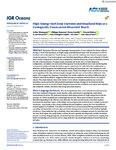High‐Energy Surf Zone Currents and Headland Rips at a Geologically Constrained Mesotidal Beach
| dc.contributor.author | Mouragues, A | |
| dc.contributor.author | Bonneton, P | |
| dc.contributor.author | Castelle, B | |
| dc.contributor.author | Marieu, V | |
| dc.contributor.author | Jak McCarroll, R | |
| dc.contributor.author | Rodriguez‐Padilla, I | |
| dc.contributor.author | Scott, T | |
| dc.contributor.author | Sous, D | |
| dc.date.accessioned | 2021-10-22T10:44:04Z | |
| dc.date.available | 2021-10-22T10:44:04Z | |
| dc.date.issued | 2020-10 | |
| dc.identifier.issn | 2169-9275 | |
| dc.identifier.issn | 2169-9291 | |
| dc.identifier.other | e2020JC016259 | |
| dc.identifier.uri | http://hdl.handle.net/10026.1/18153 | |
| dc.description.abstract |
<jats:title>Abstract</jats:title><jats:p>We analyze Eulerian and Lagrangian measurements of wave‐induced circulation collected during a 3‐week field experiment at a high‐energy mesotidal barred beach with the presence of a 500‐m headland and a submerged reef. Small changes in wave and tide conditions were found to largely impact circulation patterns. Three main regimes were identified depending on offshore wave obliquity: (1) Under shore‐normal configuration, the flow was dominated by cross‐shore motions, except for moderate waves at low tide, with the presence of a quasi‐steady circulation cell on the reef. (2) Under shadowed configuration, an onshore‐directed current flowing away from the headland and a weak oscillating eddy were present outside and inside the shadow region, respectively. (3) Under deflection configuration, a deflection rip flowing against the headland and extending well beyond the surf zone was present, with activity maximized around low tide for moderate waves. Under 4‐m oblique waves, the deflection rip was active regardless of the tide with mean depth‐averaged velocities up to 0.7 m/s 800‐m offshore in 12‐m depth, with energetic low‐frequency fluctuations. Our results emphasize the ability of deflection rips to transport materials far offshore, suggesting that such rips can transport sediment beyond the depth of closure. This study indicates that a wide variety of wave‐driven circulation patterns can occur and sometimes coexist on beaches with prominent geological settings. Changes in the dominant driving mechanism can occur as a result of small changes in wave and tide conditions, resulting in more spatially and temporally variable circulation than along open sandy beaches.</jats:p> | |
| dc.language | en | |
| dc.language.iso | en | |
| dc.publisher | American Geophysical Union | |
| dc.subject | rip currents | |
| dc.subject | field measurements | |
| dc.subject | nearshore circulation | |
| dc.subject | headland rips | |
| dc.subject | geological constraints | |
| dc.subject | very low frequency | |
| dc.title | High‐Energy Surf Zone Currents and Headland Rips at a Geologically Constrained Mesotidal Beach | |
| dc.type | journal-article | |
| dc.type | Article | |
| plymouth.author-url | https://www.webofscience.com/api/gateway?GWVersion=2&SrcApp=PARTNER_APP&SrcAuth=LinksAMR&KeyUT=WOS:000612077200049&DestLinkType=FullRecord&DestApp=ALL_WOS&UsrCustomerID=11bb513d99f797142bcfeffcc58ea008 | |
| plymouth.issue | 10 | |
| plymouth.volume | 125 | |
| plymouth.publication-status | Published | |
| plymouth.journal | Journal of Geophysical Research: Oceans | |
| dc.identifier.doi | 10.1029/2020jc016259 | |
| plymouth.organisational-group | /Plymouth | |
| plymouth.organisational-group | /Plymouth/Faculty of Science and Engineering | |
| plymouth.organisational-group | /Plymouth/Faculty of Science and Engineering/School of Biological and Marine Sciences | |
| plymouth.organisational-group | /Plymouth/REF 2021 Researchers by UoA | |
| plymouth.organisational-group | /Plymouth/REF 2021 Researchers by UoA/UoA07 Earth Systems and Environmental Sciences | |
| plymouth.organisational-group | /Plymouth/Users by role | |
| plymouth.organisational-group | /Plymouth/Users by role/Academics | |
| dcterms.dateAccepted | 2020-10-03 | |
| dc.rights.embargodate | 2021-10-23 | |
| dc.identifier.eissn | 2169-9291 | |
| dc.rights.embargoperiod | Not known | |
| rioxxterms.versionofrecord | 10.1029/2020jc016259 | |
| rioxxterms.licenseref.uri | http://www.rioxx.net/licenses/all-rights-reserved | |
| rioxxterms.licenseref.startdate | 2020-10 | |
| rioxxterms.type | Journal Article/Review |


